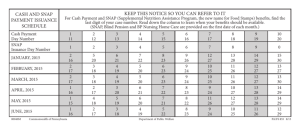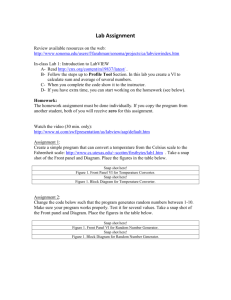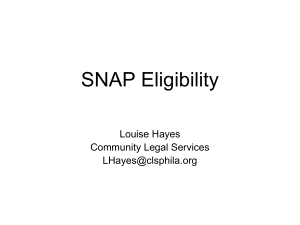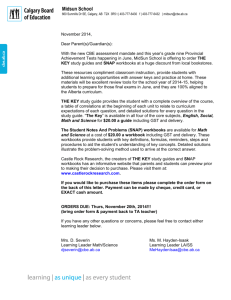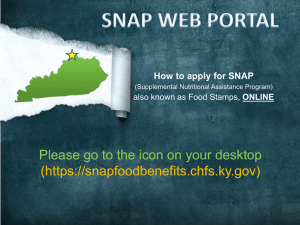SNAP Healthy Bucks Program
advertisement
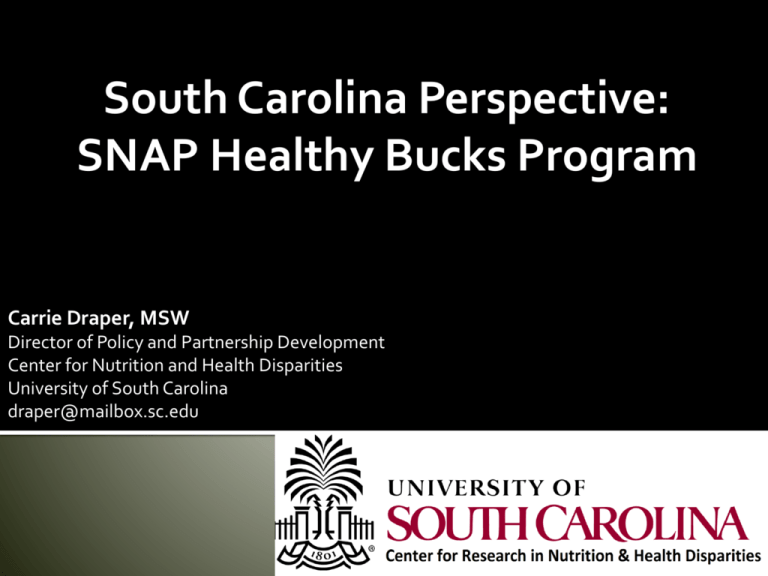
South Carolina Perspective: SNAP Healthy Bucks Program Carrie Draper, MSW Director of Policy and Partnership Development Center for Nutrition and Health Disparities University of South Carolina draper@mailbox.sc.edu RESULTS: The odds of achieving significant improvements in FV consumption increased for diabetics using financial incentives for payment at the FM (OR: 38.8, 95% CI: 3.4– 449.6) and for those frequenting the FM more often (OR: 2.1, 95% CI: 1.1–4.0). CONCLUSION: Results reveal a dose–response relationship between the intervention and FV improvements and emphasize the importance of addressing economic barriers to food access. SNAP participants in SC want to purchase fresh healthy foods at farmers’ markets. The Midlands Family Study included 550 adults caring for children, 69% participating in SNAP. One in three of these participants shopped at farmers’ markets, and 97% said they would use their SNAP benefits at a farmers’ market if a participating one was close by to them. Shopping at farmers’ markets may help alleviate child hunger, too, as families that shopped at farmers markets reported being more food secure, including being able to protect their children from hunger.¹ Jones, S. et al (2013). [Midlands Family Study]. Unpublished raw data. 2013-2014 Appropriation Act, S. 38.26, 120th South Carolina General Assembly, 1st Sess. 38.26. (DSS: SNAP Coupons) The Department of Social Services shall establish a program to provide coupons that will allow Supplemental Nutrition Assistance Program (SNAP) recipients to obtain additional fresh fruits and vegetables when purchasing fresh produce at grocery stores or farmers markets with SNAP benefits through their EBT cards. Each coupon shall allow the beneficiary to double the amount of produce purchased, up to five dollars. The agency shall utilize all funds received in the prior and current fiscal years from the U.S. Department of Agriculture as a bonus for reducing the error rate in processing SNAP applications to fund the program. 2013-2014 Appropriation Act, S. 38.26, 120th South Carolina General Assembly, 1st Sess. Building relationships with stakeholders Developing recommendations Stakeholder sign-on Pilot season – summer/fall 2014 6 farmers’ markets $2.50 SNAP purchases = $5 in “Healthy Bucks” Reimbursement process 289 people shopping with SNAP used HB Surveys with SNAP recipients Photovoice with SNAP recipients Interviews with farmers’ market representatives Funding Acknowledgements University of South Carolina Center for Research in Nutrition & Health Disparities - COPASCities study: [National Research Initiative or Agriculture and Food Research Initiative] Grant no. 2012-69001-19615 from the USDA National Institute of Food and Agricultural Childhood Obesity A2101.code - ASPIRE-II: [Advanced Support Program for Integration of Research Excellence-II] University of South Carolina Office of the Vice President for Research Eat Smart, Move More SC Data Collection & Analyses Acknowledgements Holly Pope Amy Mattison-Faye Lauren Neely Jason Craig Katie Welborn Sonya Jones Angela Liese Barriers to Shopping at Farmer’s Market: Unaware that markets took SNAP The majority (64.8%) of survey participants were unaware that their local farmers’ markets accepted SNAP 86.9% were unaware of the Healthy Bucks incentive program Lacking information on location, days, and hours of operation Unaware of the incentive program and how it works Lack of transportation 58.4% have their own car 29.6% rely on rides from others 8.8% walk or bike Perceived markets to be expensive and only accepting cash A community participatory social action method for identifying community needs and influencing policy change Guiding question(s) Facilitated conversation Sorting Captioning Community events with leaders and decision makers/policy makers Transportation Needs of children come first Lack of variety Lack of advertising/low visibility of advertisements Grocery store assets Hours of operation/time Location/space Lack of money “It is hard to get around without a car and no type of public transportation. I don’t have a car and if I wanted to get there I’d have to walk a long way. The community buses could take people to the farmers’ market for free. If you don’t have the money, how are you supposed to get down there?” Convenience/Location Word of mouth marketing Transportation Hours of operation Quality/variety Price/affordability due to Healthy Bucks program Social and community connection Child nutrition/”For the kids” “I heard about the market from the ladies that work with the farmers market and they also work inside the family health center as dietitians, so I heard about this market through them and also through the WIC program because my son gets WIC. If Healthy Bucks was going to be at other markets, having it at a family health center is great because the location is so very important. Lots of people who work at the Family Health Center use the market and they buy lots of stuff like peanuts, fruits, and collard greens. It’s the thing to do on Fridays at work. People look forward to the fresh fruits and vegetables. We enjoyed ourselves at the market the day of this picture and I’m thankful to be able to take part in the Healthy Bucks program.” Significantly increase marketing and outreach of the program to SNAP recipients and other potential SNAP retailers. Ensure SNAP recipients are informed of the process of how to participate in the program once they arrive at a participating location (e.g., first go to the farmers’ market information tent, get EBT card swiped, etc.). Be more inclusive. Ensure SNAP recipients are part of the power and decision making structures at farmers’ markets (e.g., advisory councils, committees) and the implementation stakeholder group. Provide stipends for “SNAP Champions” in communities offering the SNAP Healthy Bucks, who can employ community organizing strategies to increase shopping with SNAP at the markets (e.g., door knocking in residential communities and at agencies). Process: not sure what the process is; a lot of paperwork; having to cut a check to farmers— “some vendors don’t want a wooden nickel, they want cash money”; having to do a 990 at the end of the year; “too daunting for just me”; very labor intensive; “different departments you have to deal with and they don’t give the same answers” Equipment: don’t know how to get equipment; confused about free equipment process; don’t have phone lines, electricity, or a wireless connection Cost: cost-prohibitive—equipment/cutting checks to vendors; expensive to reimburse someone; losing money from accepting SNAP; change in providers that charges more; “burden on small markets” Lack of Customer Base or Demand: did a lot of outreach and nobody is coming; wasn’t using it, so discontinued the services; “we don’t feel that we have a huge need for it right now”; haven’t had a lot of requests/demands from market attendees wanting this to be done Staffing Constraints: no or limited market staff— “can’t sit at one table and handle everything”; turnover in market staff Perceptions of SNAP and SNAP Users: social stigma attached to SNAP; “would need to see if it would change farmers’ opinions of whether they would still come sell at the market”; public perception Some farmers markets were not able to articulate any barriers and were not sure why a farmers markets would not accept SNAP. Resources/Capacity: being able to afford to do it; having the machine; free equipment; electricity and connections; staffing Understanding the Importance: “those in charge of the market being educated on how important SNAP is and how much business that it will circulate regardless of it being a slight hassle”; “to understand that a person may get paid on Friday and come to the market on Saturday, but that same person needs something to eat Monday through Thursday. So if they don’t have money and they are receiving SNAP, you have to make it available for them if you plan on building a community and care for the people.”; “If you care about your farmers, why wouldn’t you do it?” Knowing the Process: connections that help you navigate the system; state agencies helping; understanding the process; process being easy and online; customer service being amazing; managers knowing how to use it; having a user friendly guide of how it works Being a Part of the Farmers Market Association Having the Demand Aligning with Farmers Market Goals/Mission: “part of who we are”; “mission driven”; “main goal of the farmers market is to encourage healthy eating ... getting your local fruits and vegetables, so who wouldn’t want to spend $2 to get $5 back? If we get SNAP set-up in future, we would definitely use the Healthy Bucks Program” Create an easy to use, step-by-step guide for SC farmers markets that details the following: how to become a SNAP vendor; equipment processes; how to offer the SNAP Healthy Bucks Program; the difference between SNAP, WIC farmers market vouchers, and Senior Nutrition Farmers Market vouchers; contact information for whom to contact for each program and process; and information about SNAP usage per county and SNAP user facts to demystify stereotypes. To create a farmers market navigator system, that would help markets and individual vendors navigate the processes, in person, of becoming a SNAP vendor and offering the SNAP Healthy Bucks Program. Identify funding for market staff to manage, operate, and promote SNAP at the market. To determine accurate price comparisons between grocery store and farmers market produce. Expanded to additional markets, direct selling farmers, and a bulk produce box program Increased incentive amount from $5 to $10 Significantly more recruitment efforts from agency SNAP-Ed collaboration About $10,000 expended in HB

